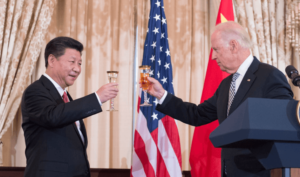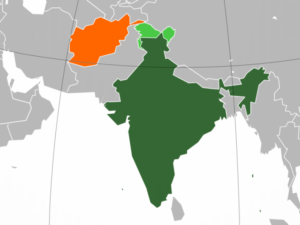By Alishbah Syed
Introduction
In our complex international landscape, a multitude of present-day global threats exist. But there are two threats that stand out as particularly pressing and existential: the unchecked climate change and a possible breakdown in nuclear deterrence. Climate change poses a threat through rising sea levels, mass displacement, ecological collapse, and widespread extinction. These impacts transcend national borders and jeopardize every nation on Earth. Meanwhile, deterrence rests on a delicate balance, where miscalculation could trigger a conflict, the world can’t afford. These are not distant doomsday scenarios, but present realities playing out on the world stage.
The true challenge arises when the two existential issues intertwine, as they often do in the inter-connected web of international relations. Rather than isolated problems, they are interconnected issues within a broader framework of international relations. The relationship between the United States and China exemplifies this duality. While cooperative efforts on climate change promote convergence, competition in deterrence drives divergence. These two areas exert influence on each other, creating an uncertain dynamic.
The crucial question is whether the cooperation fostered by climate change can spill over and mitigate the tensions surrounding deterrence, or whether the rivalry from deterrence will undermine the progress on climate. This dynamic, with its consequences for the future of humanity, will define the path that US-China relationship will take and, to a large extent, decide the fate of the international order.
Converging on Climate Change
Convergence on climate change for US and China indicates a growing recognition by both states of the urgency and gravity of climate change and having pledged to work together to curb emissions and promote clean energy. This could be especially seen in November 2014, during Obama’s visit to China.
Both states have made commitments to reducing their greenhouse gas emissions to set the bar high for the rest to follow. Additionally, both the US and China are exploring collaborative efforts on renewable energy development and sustainable technology through initiatives like US-China Clean Energy Research Center (CERC), Mission Innovation and Asian Development Bank’s energy sector group.
There was a disruption of this ‘climate diplomacy’ due to US leaving the Paris Agreement in 2014 in Trump era. But we can see the current President Biden re-entering US in 2021 and reaffirming US commitment to the Paris Agreement along with China’s President Xi Jinping to cooperate on areas like clean energy research and methane emissions reduction.
After President Biden fulfilled his promise of re-joining the Paris Agreement; US set its NDC (Nationally Determined Contribution) in April 2021 to a 50-52% reduction in emissions below 2005 levels by 2030, carbon pollution-free power sector by 2035 and net-zero emissions economy-wide by 2050.
China also set up its NDC in 2020 and submitted to the UN Framework Convention on Climate Change (UNFCCC) in October 2021 to have peak emissions by 2030 and carbon neutrality by 2060 with lower carbon dioxide emissions per unit of GDP by over 65% from the 2005 level.
Despite challenges faced in other sectors that make climate cooperation difficult, the US-China Sunnyland’s statement allowed for a stabilization in their relations and a pledge to “accelerate the substitution for coal, oil and gas generation” before the awaited COP28 summit. The awaited summit in Dubai reaffirmed the growing cooperation in climate change between US and China with both leading the Global Stocktake under the Paris Agreement and the Methane and Non-CO2 Gases summit, taking the lead in moving the climate cooperation forward.
So both countries remain committed to the UNFCCC and the Paris Agreement on climate change in the context of their own capability, national circumstances and equity to mitigate the adverse impacts of climate change. This can be, at times, despite the rivalry between US and China. This can be observed clearly in the National Security Strategy of 2022 under the Biden administration as it states “out-competing China” while in the same breath committing to not “let the disagreements that divide us stop us from moving forward on the priorities that demand that we work together, for the good of our people and for the good of the world.” One of the main priorities being climate change; showcasing how climate change opens up the possibility of fostering cooperation by being a common challenge.
Diverging on Deterrence
Divergence on deterrence for US and China indicates the growing dangerous mistrust between the two powers. The inherent anarchy and unpredictability present in the international arena is a plight that has compelled even the most powerful states to manage their insecurity. In this case, US and China experience the similar dilemma with each other; being sworn rivals. US sees a challenger to its global leadership in China through situations like the South China Sea issue and Taiwan issue while China sees an obstacle in its re-emergence as a great power in US through situations like the pushback against its BRI project and ‘One-China’ policy with Taiwan.
Both are stuck in a toxic security dilemma, having grievances of security concerns from each other like military modernization, expanding influence and interferences. One needs not to look in the history books to see a Thucydides trap scenario when it is right in the backyard of the international arena.
In response to a growing need to evolve their NDS (National Defense Strategy) in the current times, US came up with “Integrated Deterrence” while China came up with “Comprehensive National Security Plan”. US aimed to deter adversaries across all domains (military, economic, diplomatic, and informational) by combining various capabilities through close coordination and cooperation with allies. China aimed for a broader view of national security beyond military threats, focusing on a hierarchy of security including economic, social, environmental, and technological vulnerabilities. This was an effort towards the “securitization of everything”.
While the US is focusing on external threats through flexible force posture and robust alliances, China is focused on a holistic approach with a focus on internal threats through internal stability and economic security.
Having different deterrence strategies and approaches to security, whilst being nuclear powers, in the context of being rivals creates a divergence of deterrence; a breeding ground for miscalculations and unintended escalation with dire consequences.
The Dual Threat Challenge
One would ask what climate change has to do with deterrence in the context of US and China. But in this interconnected cobweb of a world, it means a substantial bit.
The best way to describe it is through the African proverb,
“When elephants fight, it is the grass that suffers.”
Climate change and deterrence are not isolated issues in the relationship between US and China but are connected, impacting the prospects of one issue by the developments in the other. They are, in short, mutually reinforcing existential threats. The cooperation (convergence) from US-China’s climate change efforts can open dialogue in the security realm for deterrence. However, the conflict (divergence) from US-China’s insecurity and distrust of each other’s deterrence can exacerbate geopolitical tensions and equally close that dialogue in the collaborative and cooperative climate diplomacy.
Therefore, US-China relationship is currently characterized by a complex interplay of cooperation and competition. While both nations converge on the urgency and commitment toward climate action, they diverge on their stances on security issues.
Epilogue
There is no clear telling what may come out of the tightrope walk, with cooperation and conflict on either side, between US and China. But one thing that must be agreed upon is, with stakes as high as this, that both sides should show willingness to prioritize the common interests over their individual ambitions. This will require a great deal of creativity and compromise from both sides.
But as the established US and the rising China confront each other’s existence, they must come to realize that they have a shared destiny. One cannot get rid of the other, so US and China should accept co-existence than let the unpredictable circumstances decide whether there will be cooperation or conflict.








